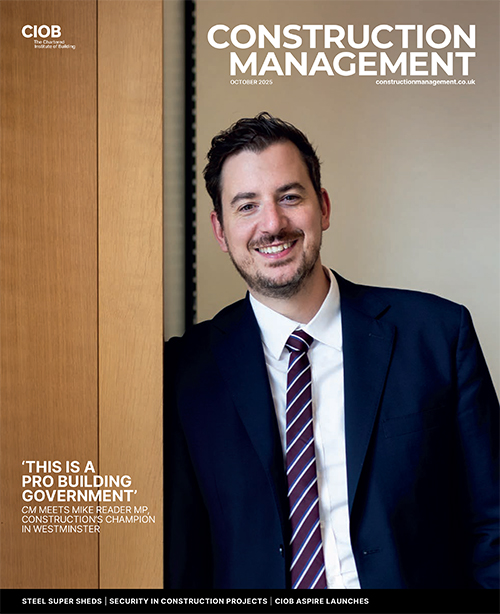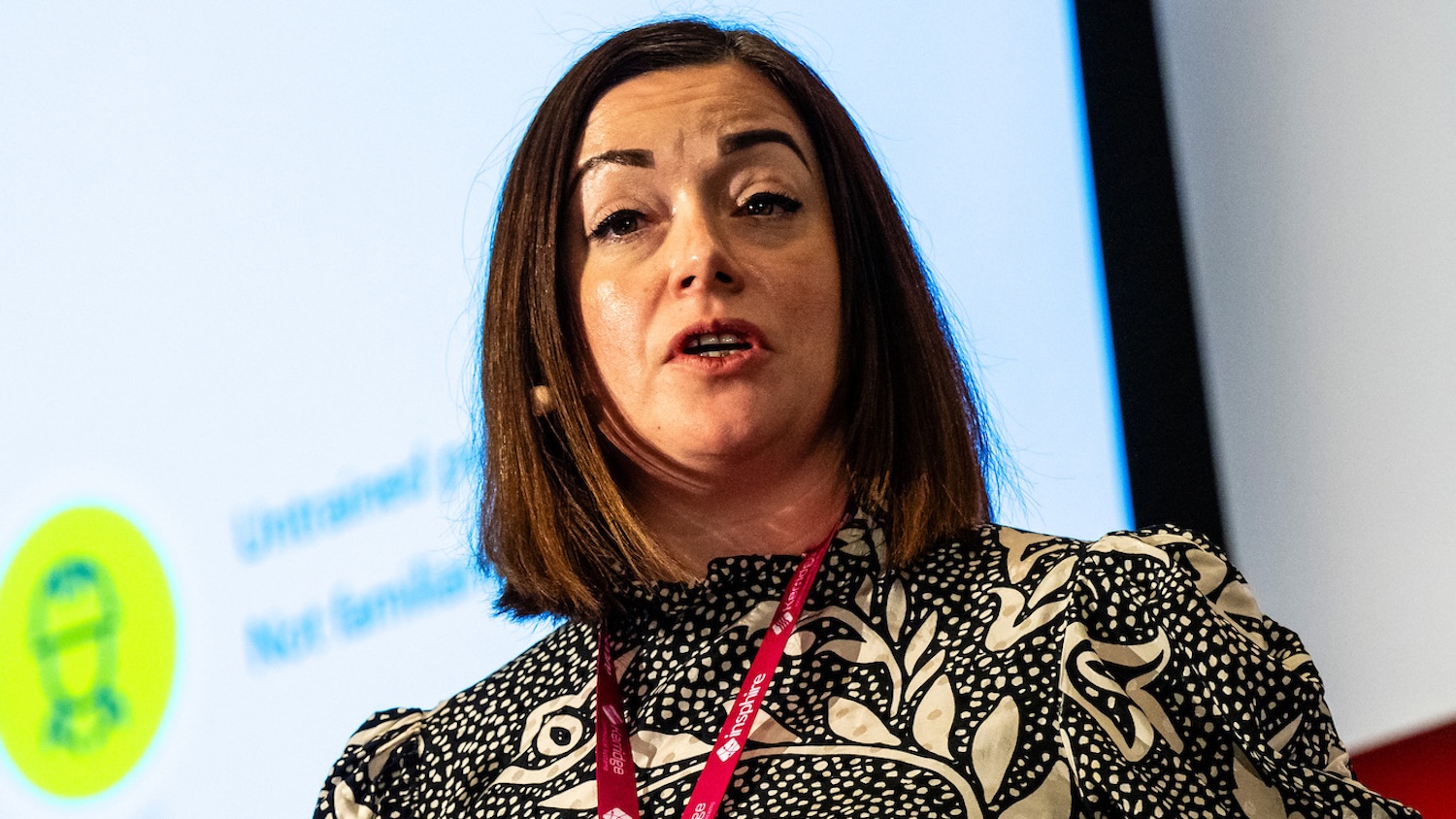
Technology in the waterproofing industry has advanced enormously in recent years. In this CPD, Proteus’s Justin Pitman explains the choices open to specifiers of protected membrane roofs and the applications of its Cold-Melt cold-applied system.
Waterproofing Technology has advanced enormously in recent years in response to health and safety concerns and the need to provide new advanced membranes that can deliver fast, cost-effective solutions for specifiers designing protected membrane inverted or warm roof applications.
What is a protected membrane (or inverted) flat roof?

A protected membrane inverted or warm flat roof is a typical flat roof construction in which the waterproofing layer is placed below the coverings, protecting the membrane from environmental conditions and traffic. Often insulation is included above the membrane which can be secured by a layer of ballast or paving, or a living green or biodiverse roof.
Such roofs are usually around 20% heavier, around 10kg per sq m, without taking into account ballast or other coverings – as compared to 8kg per sq m for a traditional cold roof where insulation is below the structural deck and the exposed waterproof membrane on top.
In addition, because of the need for ballast, paving or vegetation, inverted roofs will vary in weight and although there are lightweight solutions such as timber decking, much heavier coverings such as green roofs when saturated can be over 150kg per sq m.
Even with standard ballast or paving the weight will be typically around 90kg per sq m, which means that the structural load can be an inhibiting factor for a specifier.
However, inverted roofs are able to exceed Building Regulations Part L requirements, and have many advantages. Placing the thermal insulation above the waterproofing membrane helps to maintain waterproofing at an even temperature, protects waterproofing from UV radiation and impact damage and enables the waterproof layer to act as a vapour barrier, eliminating the risk of condensation.
Rain that falls on the roof percolates through the ballast and between the insulation boards until it reaches the membrane. It then drains away through rainwater outlets. The build-up of the roof means that some water is almost always trapped beneath the insulation boards by capillary action. Consequently, the insulation is expected to be wet for the majority of its lifetime. This is taken into consideration when determining the U-value of the roof.
Condensation risk calculations are carried out assuming that the membrane is on the warm side of the insulation. This is generally fine, but during heavy rainfall the membrane can become “chilled” by the water that percolates through the ballast and insulation and then sits on top of the membrane.

Eventually, the standing water will be warmed up by the roof deck, but until this happens, the temperature of the membrane may be below the dew point.
In recent years, polypropylene water-reducing layers have been introduced to the build-up directly above the insulation to control the flow of precipitation. These membranes ensure that the volume of water surrounding the insulation at any one time is kept at a level which does not materially affect the overall thermal performance of the system.
Where is it installed?
Inverted roofing is typically installed on a concrete deck because a loading of 80kg per sq m is required to retain the insulation on the roof. Timber decks are frequently used for ancillary areas such as balconies.
In-situ concrete is the easiest to apply, ideally without a screed to falls, as this can complicate the application and delay the installation programme. In-situ concrete typically requires a minimum of 28 days to cure before roofing works can begin, although this depends on the type of membrane specified. In the case of Proteus’ Cold-Melt system, for example, this can be applied to green concrete three days after it has been installed.
Precast concrete can also be used, with or without a screed, but the installation method will alter slightly as the panel gaps must be considered if not using a screed. If screeded, it will require a drying time. The relevant standard is BS EN 13693:2004+A1:2009.
Waterproofing membranes
A wide range of waterproofing membranes can be used in inverted roof applications, including built-up felt, single-ply membranes, cold-applied liquid membranes, mastic asphalt and hot melt monolithic waterproofing and now Cold-Melt.
Built-up felt systems
Built-up felt or reinforced bitumen membranes – traditionally the first choice for inverted roofs – are increasingly losing out to other types of waterproofing which are quicker to install, particularly around detailed areas, and often less expensive. These systems require a two-layer application which can be fully bonded or loose laid, and from 6-8mm thick.

Built-up felt systems are not seamless and bituminous laps suffer from attack from algae which form in standing water, meaning that this type of membrane choice has long been overtaken by other, more robust, technologies. Specified in the right situation, bitumen membranes typically last for 20-35 years.
Single-ply membranes
Single-ply membranes are mostly suited to warm roof applications, however some have been historically specified for inverted roofs. Their thickness ranges from 1.2-2mm, which combined with their composition makes them prone to damage by following trades, so it is usually advisable to add a fleece membrane.
Single ply is not seamless and some types of membrane suffer from algae attack. In addition, the seams between the sheets are susceptible to failure if the initial weld was not perfectly achieved at the point of installation. Single-ply membranes typically last for 20-30 years.
Liquid applied membranes
Until recently these were mostly used in refurbishment applications but are increasingly specified for new-build, though many are not suitable for inverted roofs. Thicknesses are typically 2mm minimum and once cured are generally tougher than single-ply membranes. They are fully bonded and usually need a two-coat application, and installation times are usually quicker than single-ply or built-up felt. Because of their seamless application, robust detailing is easier to achieve than with felt or single ply.
Most liquids are not suitable for inverted applications as they can suffer from osmosis, where water molecules pass through the finished waterproofing and cause it to break down and fail over time.
Once cured and correctly specified, liquid membranes provide a seamless, robust penetration resistant surface with a design life of 20-35 years.
Mastic asphalt and hot melt monolithic membranes
Traditional mastic asphalt and more recent hot-melt rubber systems are the most common waterproofing for inverted roofs. Thicknesses from 8-10mm mean minimal risk of damage by following trades. They are fully bonded to primed substrate, preventing water tracking if punctured. The two-coat application is easy to apply, and they accommodate high volumes of penetrations easily.
Heavy plant and melting equipment, including agitating mixers, are required to facilitate the material prior to application which requires gas and hot works. Smaller balcony areas can be hard to access due to the size of the machinery involved.
Most of these systems are certified by the British Board of Agrément (BBA) for “the design life of the roof or structure in which they are incorporated”.
Cold-Melt waterproofing membrane
Cold-Melt, available exclusively from Proteus Waterproofing, is a cold-applied two-part elastomeric polyurethane waterproofing system that provides seamless protection for concrete, asphalt, metal, wood and other substrates, including decks with zero falls.
It is suited to inverted roof applications, with fast, value-for-money installation, and is particularly good in areas of detail. It is BBA certified to last for the lifetime of the building it is protecting and is one of the greenest membranes in the world.
The trademarked Cold-Melt liquid roof system incorporates recycled rubber crumb, castor oil and other organically grown products to create an elastomeric, seamless, cold-applied membrane that is quick, simple and safe to apply.
The Cold-Melt system incorporates inverted roof insulation and, with or without insulation, can be designed as a paved, decked, ballasted, green or brown roof. The membrane does not become brittle with age and, when protected from UV exposure, it is certified to last the life of the structure.
Cold-Melt exhibits no odour and can be applied in confined spaces. As well as inverted roofs, it can be used on a range of decks including concrete, asphalt, timber/plywood and metal balconies and roofs.
How is it installed?
Cold-Melt is a tough and very flexible monolithic waterproofing membrane. As its name suggests, no naked flame or boiler is involved. Unlike other membranes, it can be installed over green concrete after three days or over damp surfaces.
The first layer, Pro-Carrier Membrane SA, is a self-adhesive bituminous waterproofing membrane that forms a barrier against vapour and gases and is laid over a pre-primed surface.
It comprises a self-adhesive, low thickness bituminous compound which is self-protected by an aluminium film. Glass fibre and polyester reinforcement provide excellent puncture resistance.
It is applied to provide a reinforcing layer to all areas receiving the Cold-Melt application and provides instant waterproofing. This layer can be left for several weeks while trades complete their works before the top Cold-Melt coat is roller applied.
The seamless Cold-Melt layer enables details such as drainage areas to be quickly completed. Once cured, it is BBA certified to last the lifetime of the building or the substrate on which it is installed.
The Cold-Melt membrane can be trafficked once cured, for applications such as balconies or podium decks, or take insulation, ballast and other materials to complete the inverted roof. Cold-Melt can be trafficked by other trades prior to being covered but would not be left as an exposed membrane – other than exposed upstands which are protected by a further coat of Cold-Melt UVR top coat.
Insulation for inverted roofs
There are two main types of insulation for inverted roofs: extruded polystyrene (XPS) and expanded polystyrene (EPS). Specifiers should check that products are certified by the BBA for inverted roof applications, green roofs and roof gardens.
They should also check that the declared thermal conductivity (or lambda value) is calculated to BBA specifications, and that the moisture conversion factor and rainwater cooling factor required by European standard ETAG 031 are applied.
XPS is the traditional choice for inverted roof systems. It should be manufactured to BS EN 13164. Some manufacturers have improved the lambda value of boards to 0.034W/m2K, enabling a 200mm-thick board to achieve a U-value of 0.15. ETAG 031-1 states that XPS is suitable for untrafficked or pedestrian areas, green roofs, roof gardens and parking decks.
EPS should be manufactured to BS EN 13163. The thermal performance is lower than for XPS with a lambda value of 0.038W/m2K. ETAG 031-1 states that EPS is also suitable for trafficked or pedestrian areas, but not for green roofs, roof gardens and parking decks.
Design considerations: zero falls
The Building Regulations refers to BS 6229:2003 in the case of falls on flat roofs. It specifies minimum finished falls of 1:80, achieved by designing to 1:40 to allow for a 25mm deflection every 1m.
In 2016, BS 6229 will be updated to include zero falls applications as defined by the BBA in Building Bulletin 4. This defines zero falls as between 0˚ and 0.7˚. The NHBC has also recognised zero falls construction in its Chapter 7.1 standards publication, updated in November 2015.
When checking the suitability of a roof for zero falls application, it is important to ensure the manufacturer assesses the deflection plan for the deck to identify any low points that are not near rainwater outlets. If the outlets cannot be moved to areas of high deflection, the options of increasing ballast, paving or green roof loading locally to disperse the water should be considered.
Sustainability
The thermal insulant and the deck type have the biggest impact on an inverted roof’s Green Guide to Specification rating. Most inverted roof insulation boards have an A or A+ rating, but as an inverted roof is usually on a concrete deck, the overall rating will be C or D.
The Green Guide informs BREEAM ratings, and here the biggest additional contribution will be the ISO 14001 certification for the manufacture of the waterproofing and the insulation. Biodiverse and intensive green roofs can also add points. In recent years, the BRE has linked its BES 6001 Responsible Sourcing of Construction Products assessment to BREEAM.
Cold-Melt on site in the City
So how does Cold-Melt work in action? A highly innovative vertical application of 1,000sq m of Proteus’ Cold-Melt waterproofing membrane provided a watertight finish at the £53m Moorgate Exchange – a landmark 12-storey development in the City of London, which created 21,000sq m of Grade A office space built to BREEAM Excellent and Platinum LEED environmental standards.
With works undertaken at a height of 3.5m on a vertical surface, it was vital that any waterproofing application followed a strict regime to ensure the health and safety of site operatives. Cold‑Melt ensured minimal disruption on site, exceptional health and safety standards and a quality, watertight finish.
For a waterproofing application within the building’s oil tank storage room, exceptional chemical resistance was a prerequisite. Cold Melt offered a fast, hassle-free and high quality solution, meeting strict application restrictions and enabling exceptional attention to detail.
Keeping fit for purpose
Some 750sq m of Cold-Melt liquid roof membrane was used to provide waterproofing protection for a state-of-the-art health and fitness centre – built as part of the £2m regeneration of Charlton Lido in south-east London.
Opened in 1939, the historic lido was closed for a two-stage refurbishment which saw a new reception, cafe and seating areas built and the 50m heated outdoor pool reopened to the public. For phase 2, a new gymnasium was created to provide leisure facilities all year round.
To waterproof the new concrete deck and provide seamless protection around perimeter details, Cold-Melt was specified to provide high performance from the concrete deck to perimeter details and hand rail brackets.
Justin Pitman is sales director with Proteus
This article has been created by Construction Manager in partnership with Proteus Waterproofing




